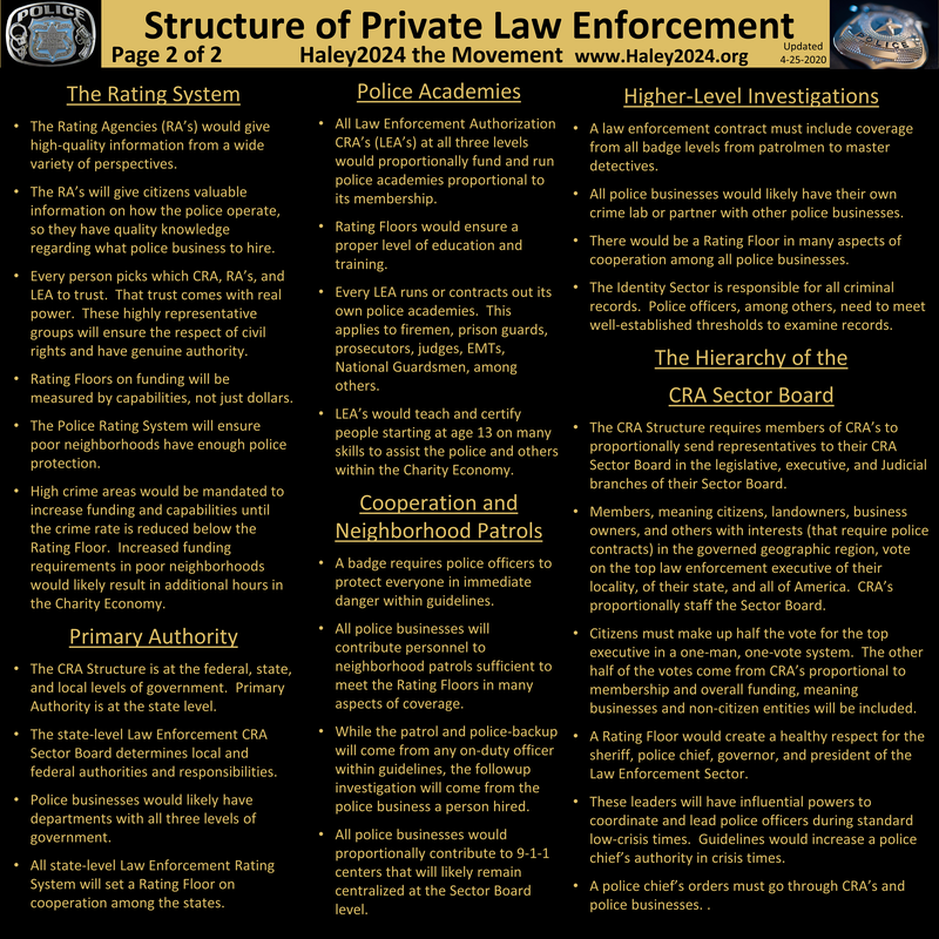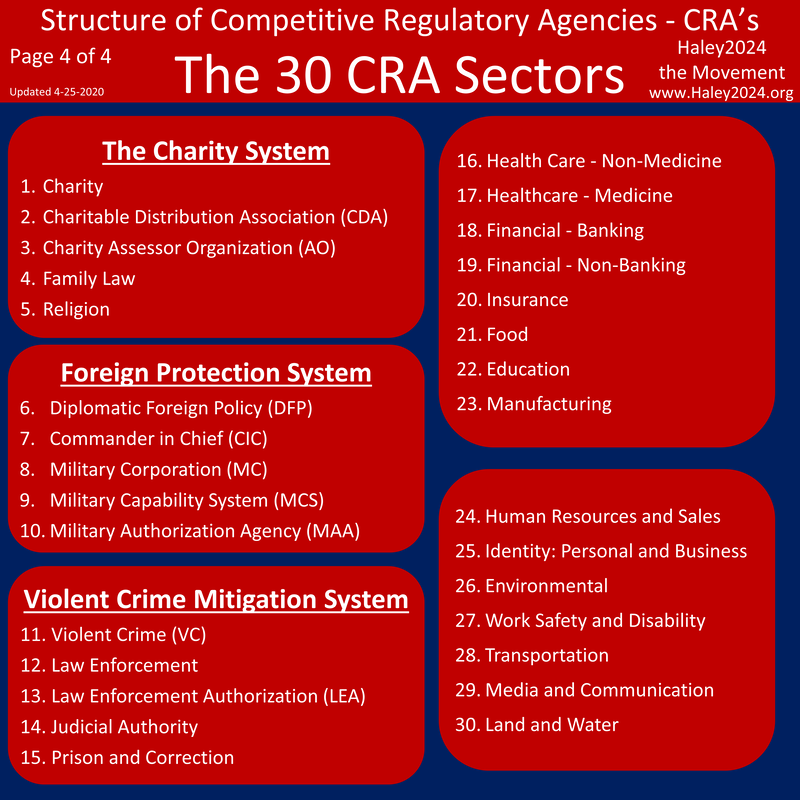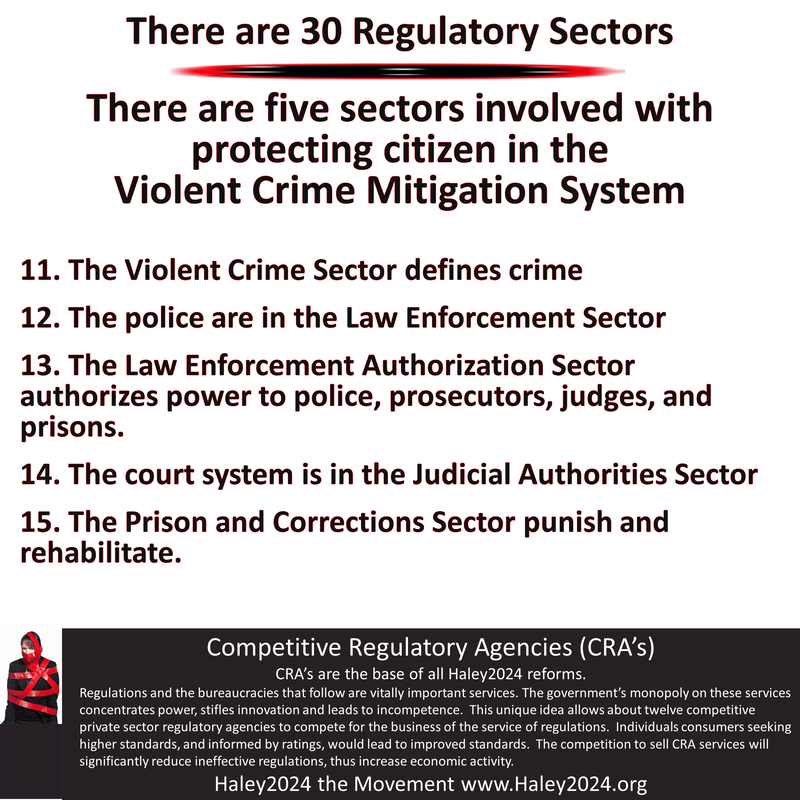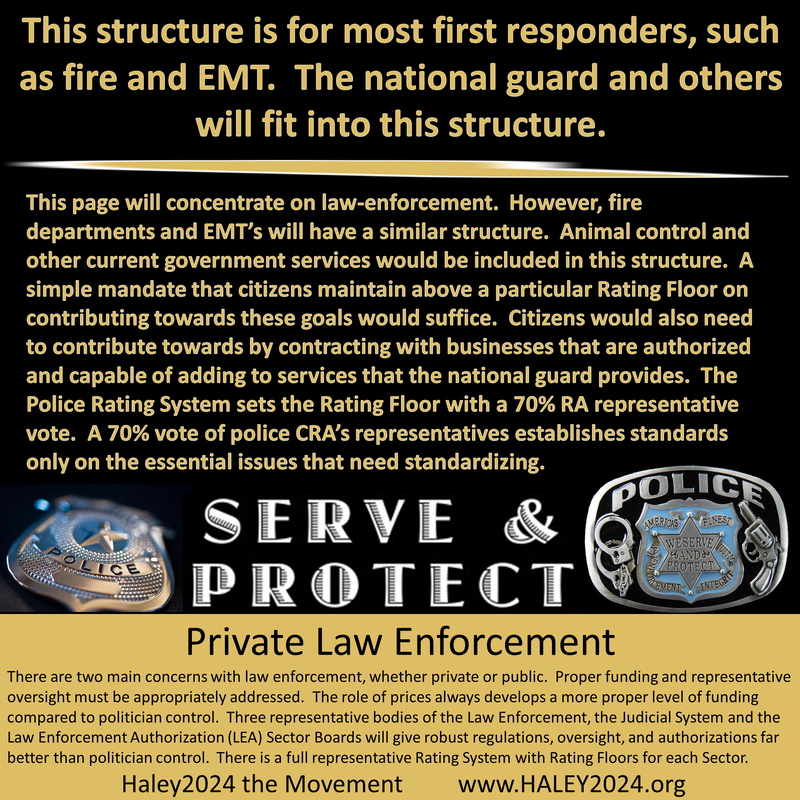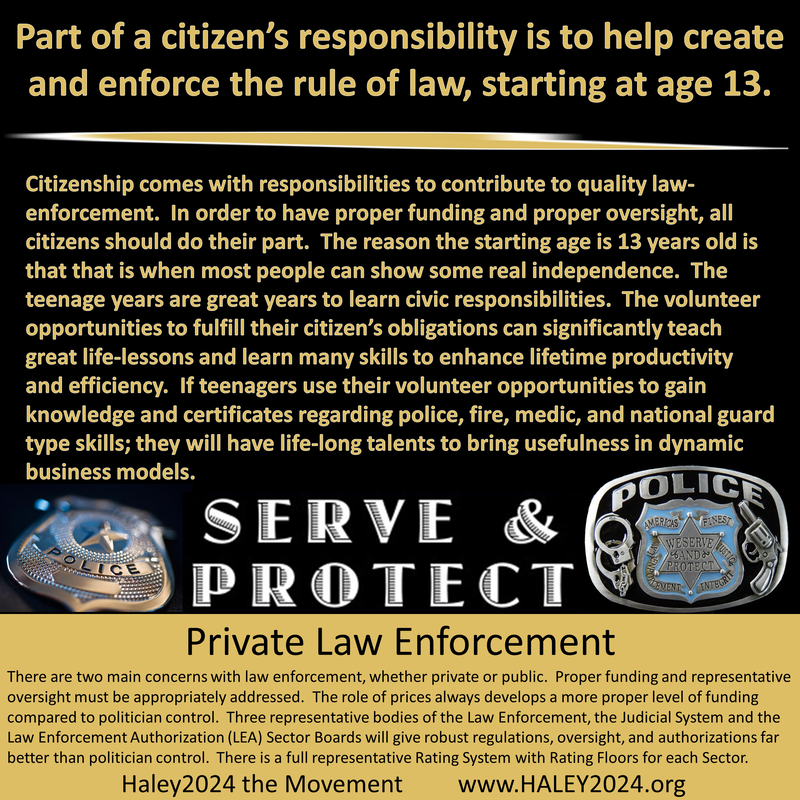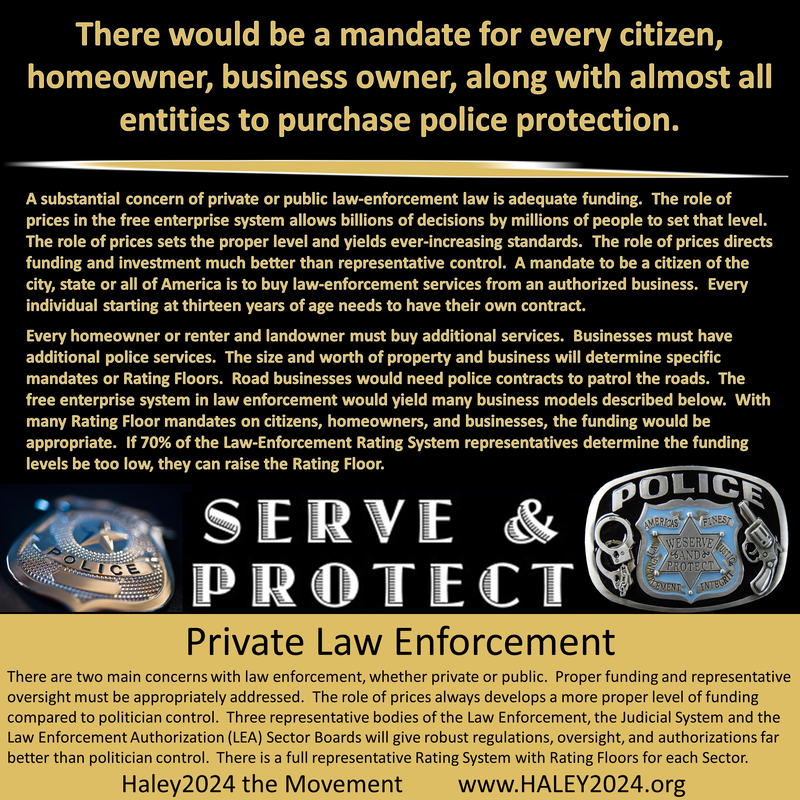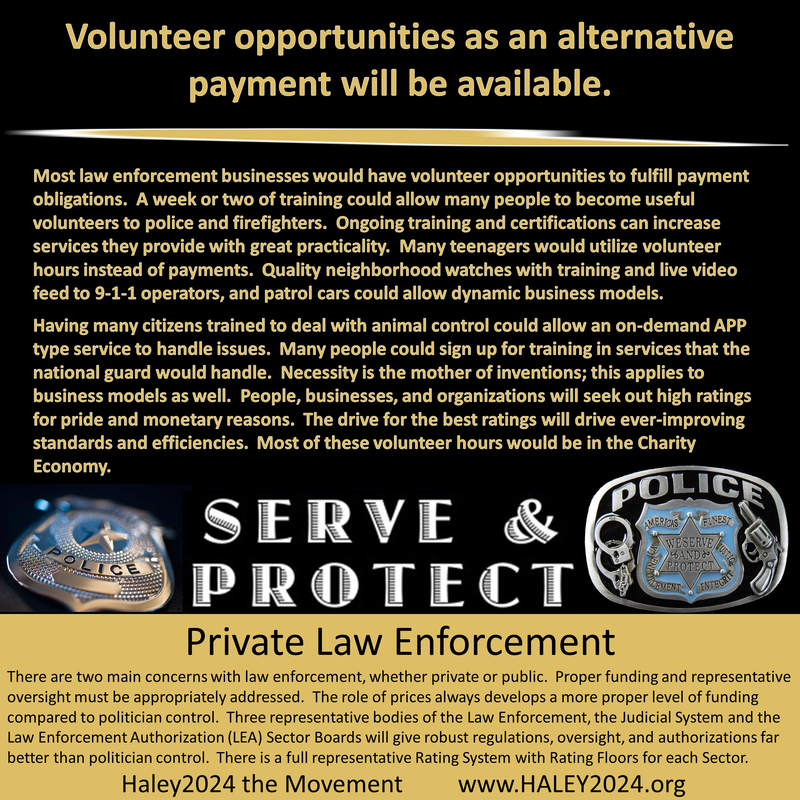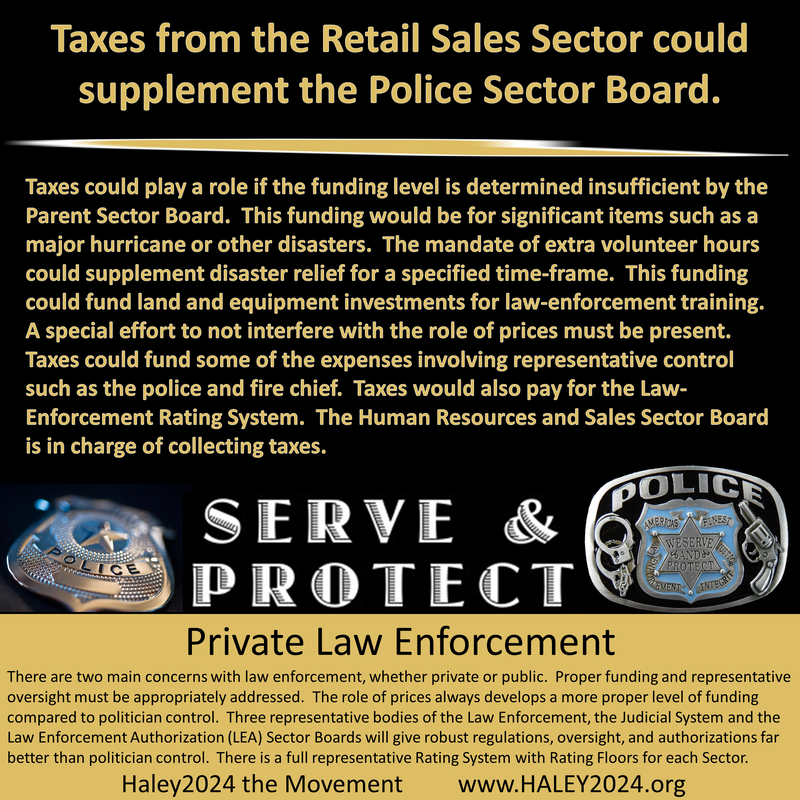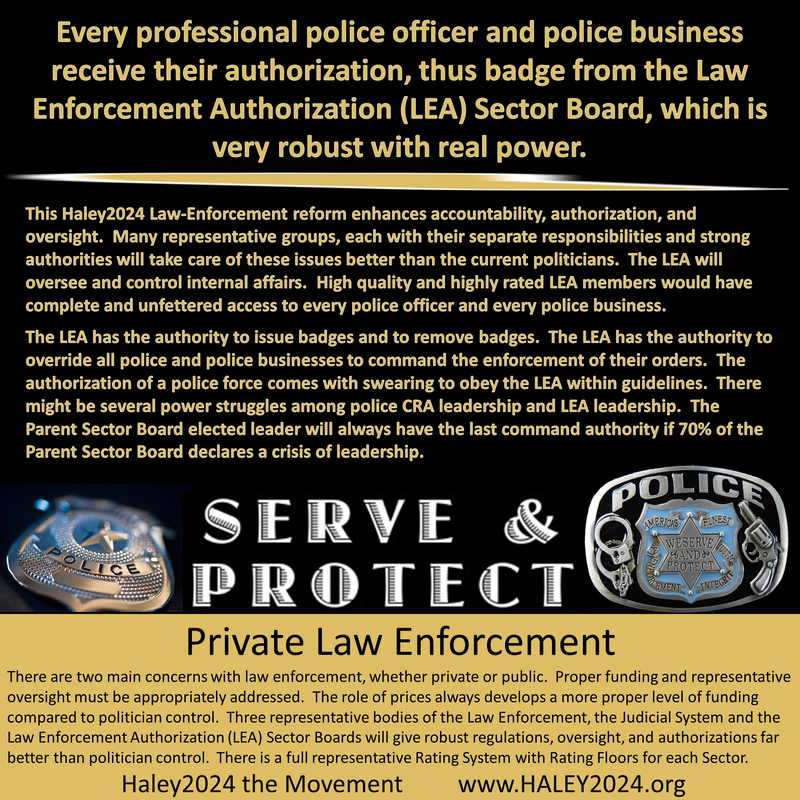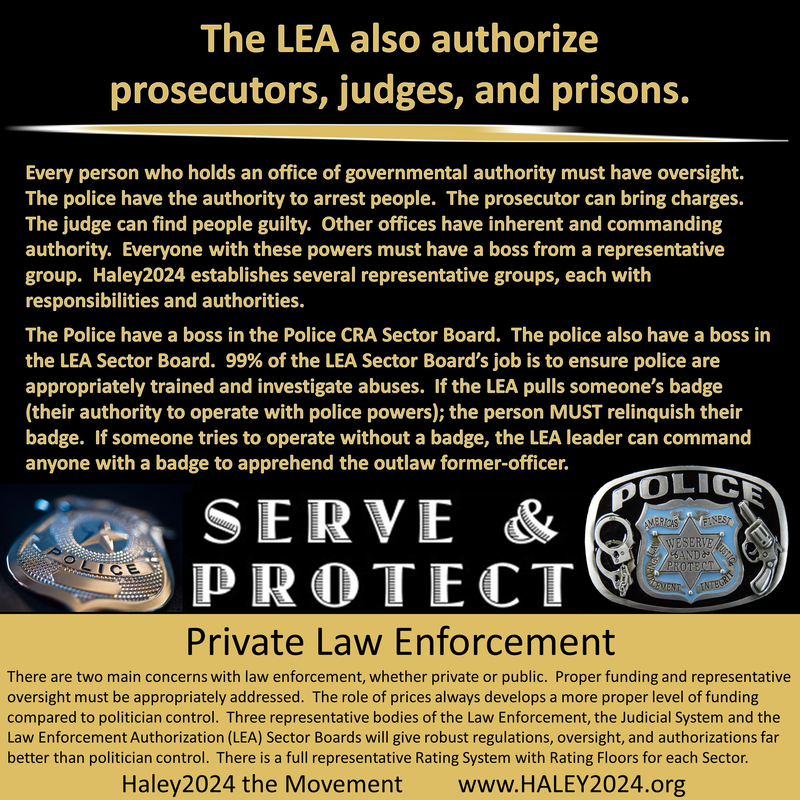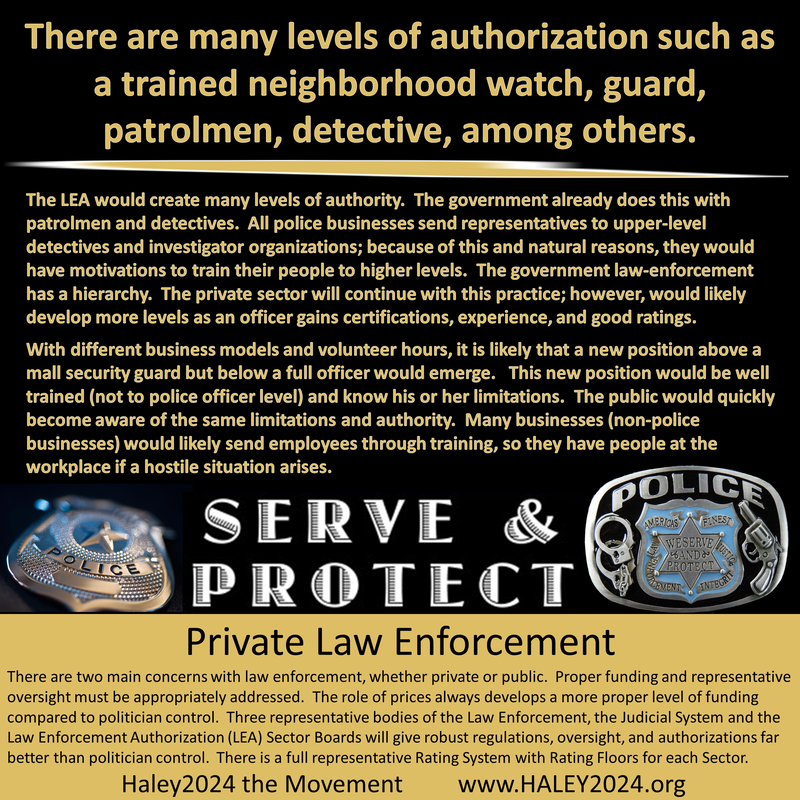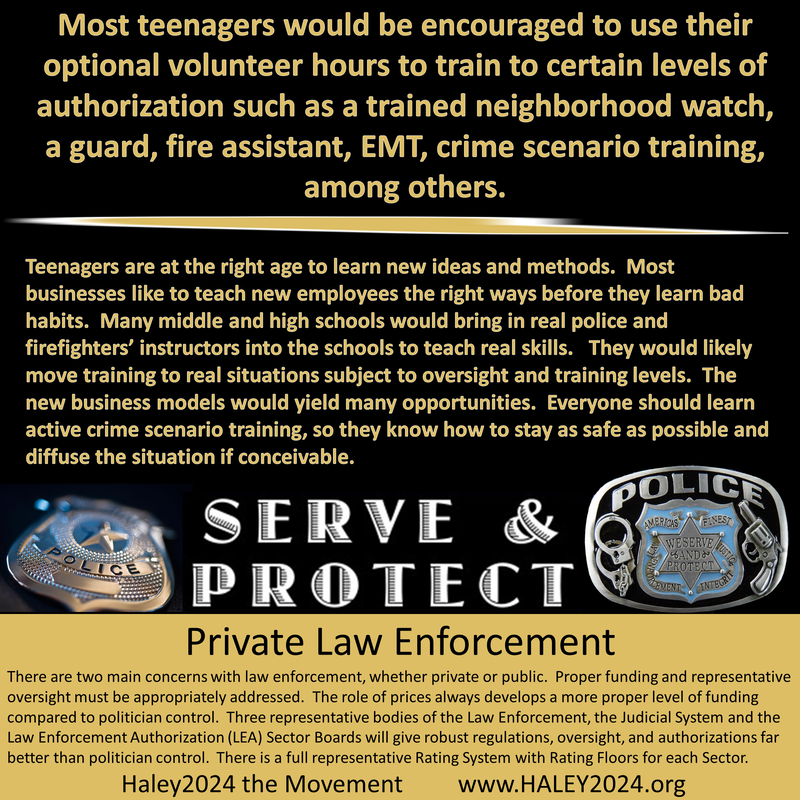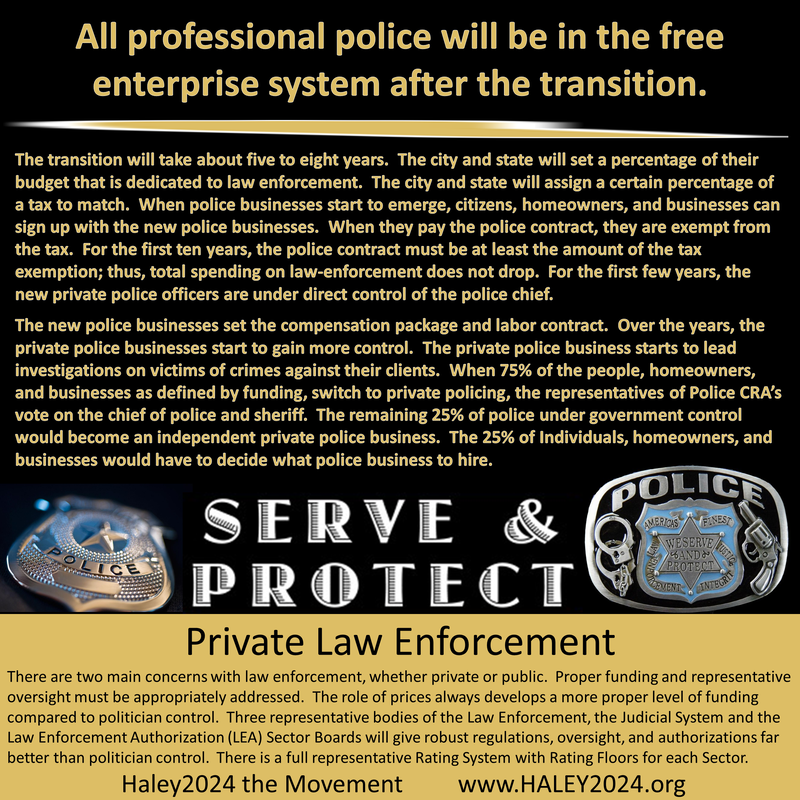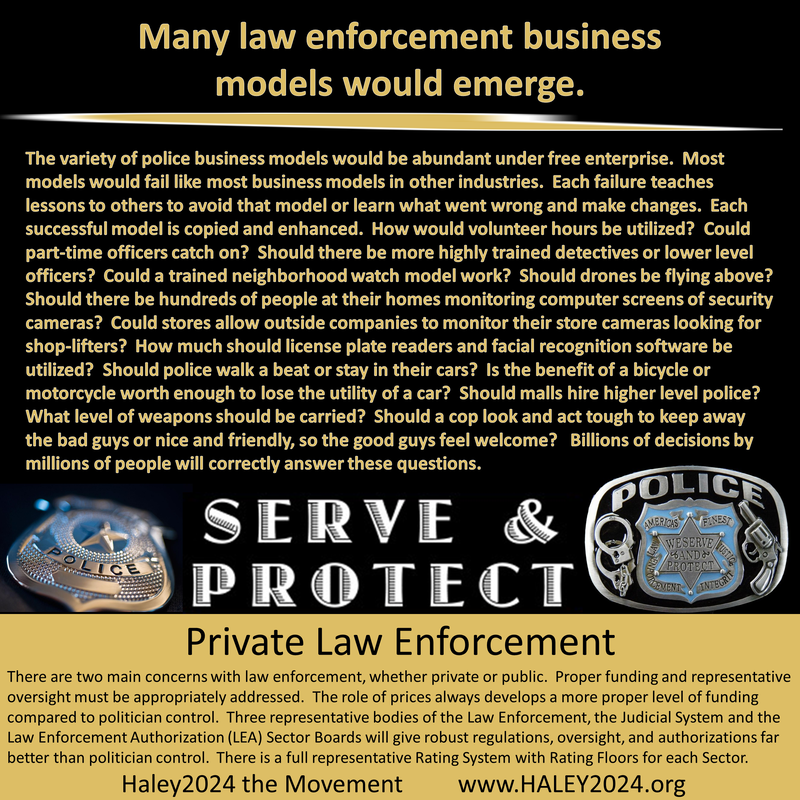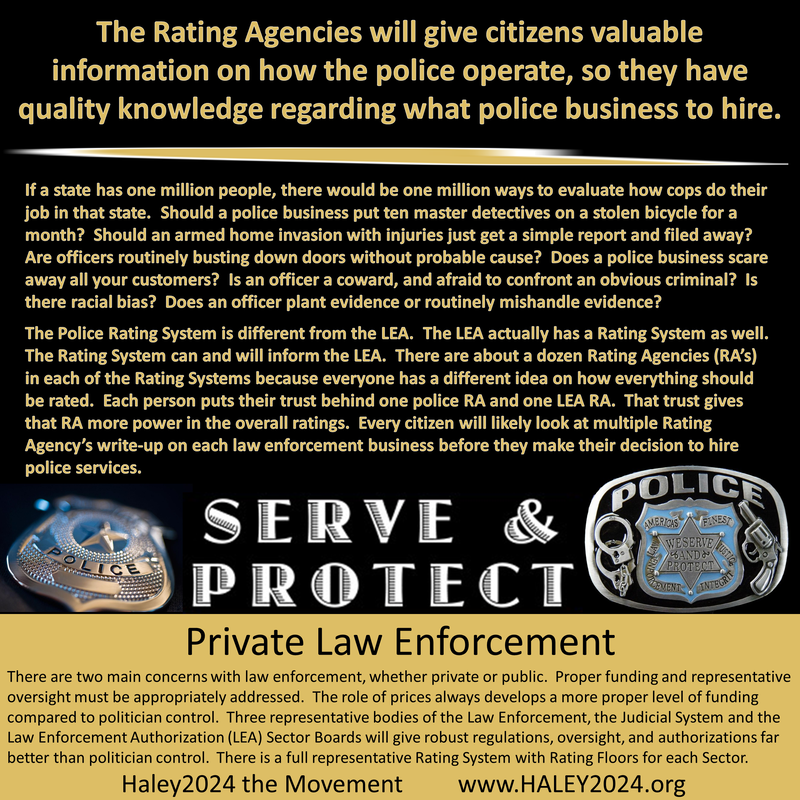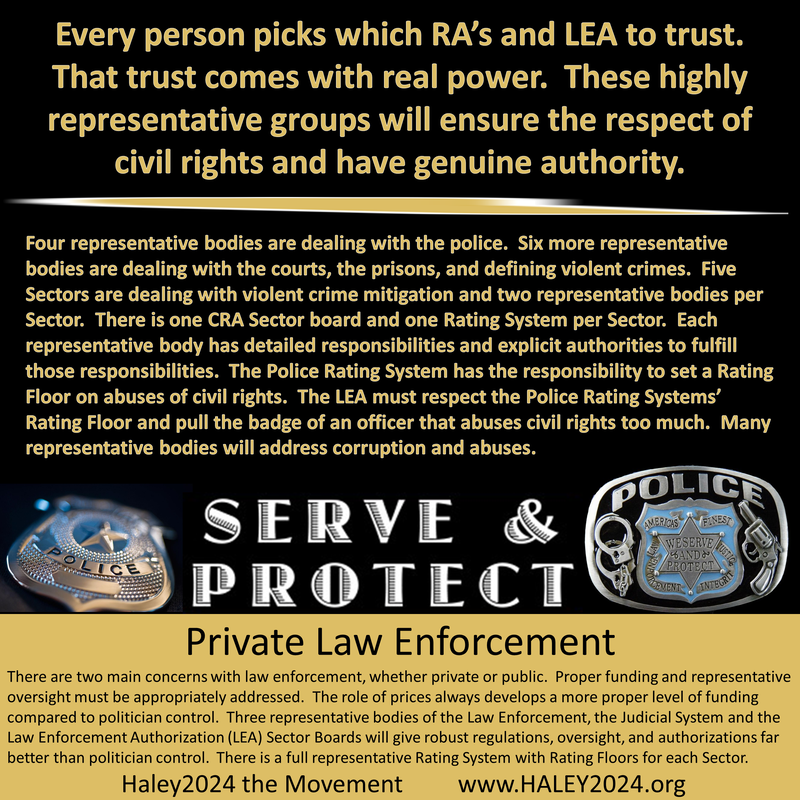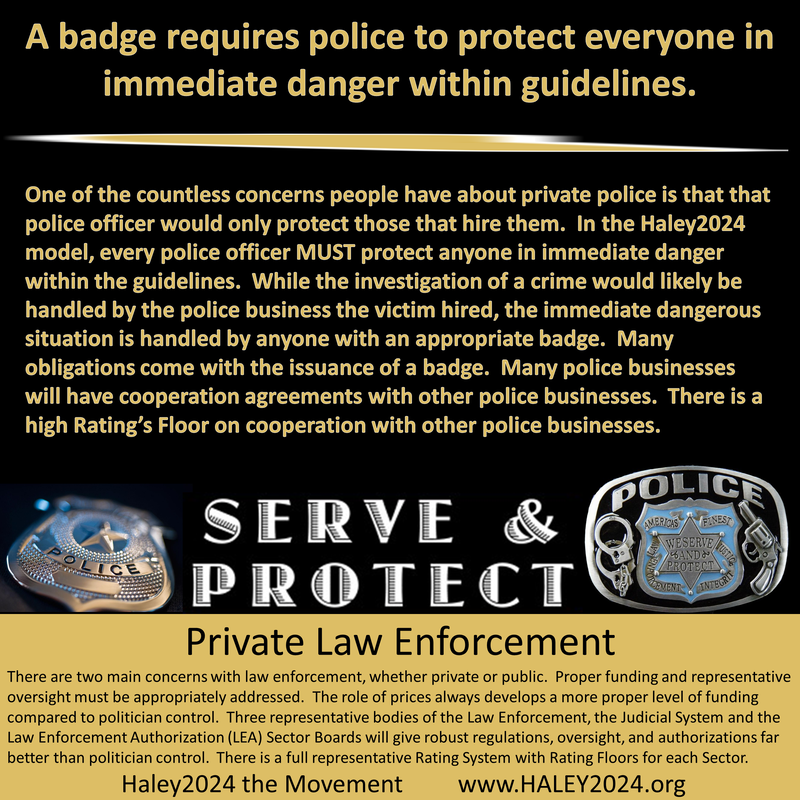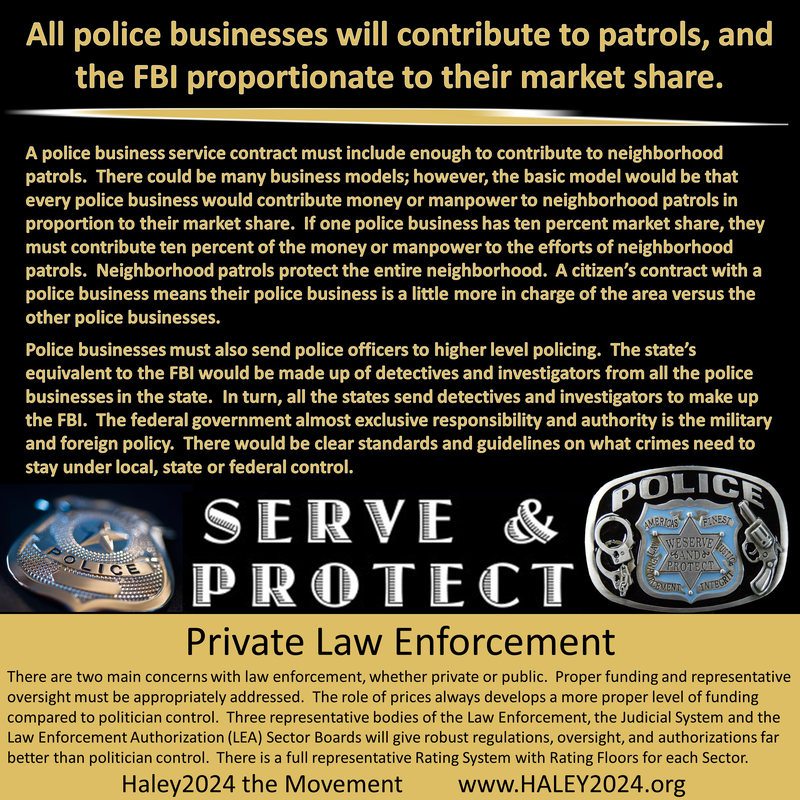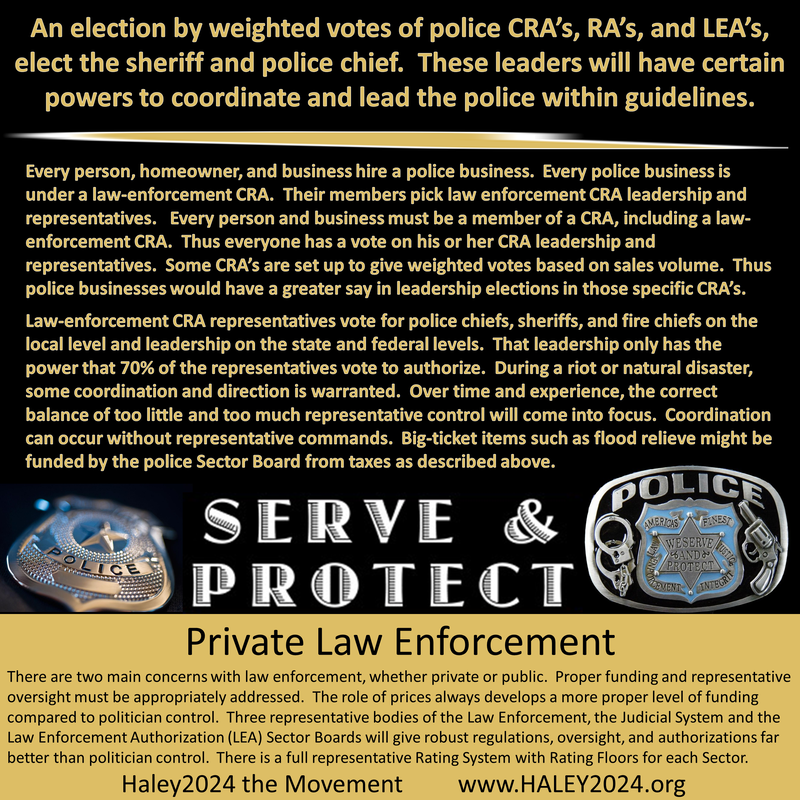The Structure of Private Law Enforcement
When explaining the law-enforcement structure, it is essential to fully understand the CRA Structure. The complete Rating System Structure and the full structure of the Violent Crime Mitigation System is vital to comprehend. The structure of the Charity System and the Charity Economy is addressed in this Law Enforcement Structure. There is a long explanation because most people can not envision private sector police. All these pages are in the drop-down menu.
The bullet points above were updated 4-25-2020. For any minor inconsistencies, please use the updated version above. I will redo this page soon; however, it remains 95% consistent.
There are two main concerns with law enforcement, whether private or public. Proper funding and representative oversight must be appropriately addressed. The role of prices always develops a more adequate level of funding compared to politician control. Four representative bodies control law-enforcement. The law-enforcement Sector Board and Law Enforcement Authorization Sector Boards will give robust regulations and authorize the police to operate. Both of these Sectors have a Rating System. The free enterprise system and these representative bodies are far better than the socialism of politician’s control. |
This structure is for most first responders, such as fire and EMT. The national guard and others will fit into this structure. This page will concentrate on law-enforcement. However, fire departments and EMT’s will have a similar structure. Animal control and other current government services would be included in this structure. A simple mandate that citizens maintain above a particular Rating Floor on contributing towards these goals would suffice. Citizens would also need to contribute towards by contracting with businesses that are authorized and capable of adding to services that the national guard provides. The Police Rating System sets the Rating Floor with a 70% RA representative vote. A 70% vote of police CRA’s representatives establishes standards only on the essential issues that need standardizing.
|
Part of a citizen’s responsibility is to help create and enforce the rule of law, starting at age 13. Citizenship comes with responsibilities to contribute to quality law-enforcement. In order to have proper funding and proper oversight, all citizens should do their part. The reason the starting age is 13 years old is that that is when most people can show some real independence. The teenage years are great years to learn civic responsibilities. The volunteer opportunities to fulfill their citizen’s obligations can significantly teach great life-lessons and learn many skills to enhance lifetime productivity and efficiency. If teenagers use their volunteer opportunities to gain knowledge and certificates regarding police, fire, medic, and national guard type skills; they will have life-long talents to bring usefulness in dynamic business models.
|
Funding
There would be a mandate for every citizen, homeowner, business owner, along with almost all entities to purchase police protection. A substantial concern of private or public law-enforcement law is adequate funding. The role of prices in the free enterprise system allows billions of decisions by millions of people to set that level. The role of prices sets the proper level and yields ever-increasing standards. The role of prices directs funding and investment much better than representative control. A mandate to be a citizen of the city, state or all of America is to buy law-enforcement services from an authorized business. Every individual starting at thirteen years of age needs to have their own contract.
Every homeowner or renter and landowner must buy additional services. Businesses must have additional police services. The size and worth of property and business will determine specific mandates or Rating Floors. Road businesses would need police contracts to patrol the roads. The free enterprise system in law enforcement would yield many business models described below. With many Rating Floor mandates on citizens, homeowners, and businesses, the funding would be appropriate. If 70% of the Law-Enforcement Rating System representatives determine the funding levels be too low, they can raise the Rating Floor. |
Volunteer opportunities as an alternative payment will be available. Most law enforcement businesses would have volunteer opportunities to fulfill payment obligations. A week or two of training could allow many people to become useful volunteers to police and firefighters. Ongoing training and certifications can increase services they provide with great practicality. Many teenagers would utilize volunteer hours instead of payments. Quality neighborhood watches with training and live video feed to 9-1-1 operators, and patrol cars could allow dynamic business models.
Having many citizens trained to deal with animal control could allow an on-demand APP type service to handle issues. Many people could sign up for training in services that the national guard would handle. Necessity is the mother of inventions; this applies to business models as well. People, businesses, and organizations will seek out high ratings for pride and monetary reasons. The drive for the best ratings will drive ever-improving standards and efficiencies. Most of these volunteer hours would be in the Charity Economy. |
Taxes from the Retail Sales Sector could supplement the Police Sector Board. Taxes could play a role if the funding level is determined insufficient by the Parent Sector Board. This funding would be for significant items such as a major hurricane or other disasters. The mandate of extra volunteer hours could supplement disaster relief for a specified time-frame. This funding could fund land and equipment investments for law-enforcement training. A special effort to not interfere with the role of prices must be present. Taxes could fund some of the expenses involving representative control such as the police and fire chief. Taxes would also pay for the Law-Enforcement Rating System. The Human Resources and Sales Sector Board is in charge of collecting taxes.
|
Accountability, Authorization, and Oversight
Every professional police officer and police business receive their authorization, thus badge from the Law Enforcement Authorization (LEA) Sector Board, which is very robust with real power. This Haley2024 Law-Enforcement reform enhances accountability, authorization, and oversight. Many representative groups, each with their separate responsibilities and strong authorities will take care of these issues better than the current politicians. The LEA will oversee and control internal affairs. High quality and highly rated LEA members would have complete and unfettered access to every police officer and every police business.
The LEA has the authority to issue badges and to remove badges. The LEA has the authority to override all police and police businesses to command the enforcement of their orders. The authorization of a police force comes with swearing to obey the LEA within guidelines. There might be several power struggles among police CRA leadership and LEA leadership. The Parent Sector Board elected leader will always have the last command authority if 70% of the Parent Sector Board declares a crisis of leadership. |
The LEA also authorize prosecutors, judges, and prisons. Every person who holds an office of governmental authority must have oversight. The police have the authority to arrest people. The prosecutor can bring charges. The judge can find people guilty. Other offices have inherent and commanding authority. Everyone with these powers must have a boss from a representative group. Haley2024 establishes several representative groups, each with responsibilities and authorities.
The Police have a boss in the Police CRA Sector Board. The police also have a boss in the LEA Sector Board. 99% of the LEA Sector Board’s job is to ensure police are appropriately trained and investigate abuses. If the LEA pulls someone’s badge (their authority to operate with police powers); the person MUST relinquish their badge. If someone tries to operate without a badge, the LEA leader can command anyone with a badge to apprehend the outlaw former-officer. |
There are many levels of authorization such as a trained neighborhood watch, guard, patrolmen, detective, among others. The LEA would create many levels of authority. The government already does this with patrolmen and detectives. All police businesses send representatives to upper-level detectives and investigator organizations; because of this and natural reasons, they would have motivations to train their people to higher levels. The government law-enforcement has a hierarchy. The private sector will continue with this practice; however, would likely develop more levels as an officer gains certifications, experience, and good ratings.
With different business models and volunteer hours, it is likely that a new position above a mall security guard but below a full officer would emerge. This new position would be well trained (not to police officer level) and know his or her limitations. The public would quickly become aware of the same limitations and authority. Many businesses (non-police businesses) would likely send employees through training, so they have people at the workplace if a hostile situation arises. |
Most teenagers would be encouraged to use their optional volunteer hours to train to certain levels of authorization such as a trained neighborhood watch, a guard, fire assistant, EMT, crime scenario training, among others. Most teenagers would be encouraged to use their optional volunteer hours to train to certain levels of authorization such as a trained neighborhood watch, a guard, fire assistant, EMT, crime scenario training, among others.
Teenagers are at the right age to learn new ideas and methods. Most businesses like to teach new employees the right ways before they learn bad habits. Many middle and high schools would bring in real police and firefighters’ instructors into the schools to teach real skills. They would likely move training to real situations subject to oversight and training levels. The new business models would yield many opportunities. Everyone should learn active crime scenario training, so they know how to stay as safe as possible and diffuse the situation if conceivable. |
Free Enterprise
All professional police will be in the free enterprise system after the transition. The transition will take about five to eight years. The city and state will set a percentage of their budget that is dedicated to law enforcement. The city and state will assign a certain percentage of a tax to match. When police businesses start to emerge, citizens, homeowners, and businesses can sign up with the new police businesses. When they pay the police contract, they are exempt from the tax. For the first ten years, the police contract must be at least the amount of the tax exemption; thus, total spending on law-enforcement does not drop. For the first few years, the new private police officers are under direct control of the police chief.
The new police businesses set the compensation package and labor contract. Over the years, the private police businesses start to gain more control. The private police business starts to lead investigations on victims of crimes against their clients. When 75% of the people, homeowners, and businesses as defined by funding, switch to private policing, the representatives of Police CRA’s vote on the chief of police and sheriff. The remaining 25% of police under government control would become an independent private police business. The 25% of Individuals, homeowners, and businesses would have to decide what police business to hire. |
Many law enforcement business models would emerge. The variety of police business models would be abundant under free enterprise. Most models would fail like most business models in other industries. Each failure teaches lessons to others to avoid that model or learn what went wrong and make changes. Each successful model is copied and enhanced. How would volunteer hours be utilized? Could part-time officers catch on? Should there be more highly trained detectives or lower level officers? Could a trained neighborhood watch model work? Should drones be flying above? Should there be hundreds of people at their homes monitoring computer screens of security cameras? Could stores allow outside companies to monitor their store cameras looking for shop-lifters? How much should license plate readers and facial recognition software be utilized? Should police walk a beat or stay in their cars? Is the benefit of a bicycle or motorcycle worth enough to lose the utility of a car? Should malls hire higher level police? What level of weapons should be carried? Should a cop look and act tough to keep away the bad guys or nice and friendly, so the good guys feel welcome? Billions of decisions by millions of people will correctly answer these questions.
|
The Rating System
The Rating Agencies will give citizens valuable information on how the police operate, so they have quality knowledge regarding what police business to hire. If a state has one million people, there would be one million ways to evaluate how cops do their job in that state. Should a police business put ten master detectives on a stolen bicycle for a month? Should an armed home invasion with injuries just get a simple report and filed away? Are officers routinely busting down doors without probable cause? Does a police business scare away all your customers? Is an officer a coward, and afraid to confront an obvious criminal? Is there racial bias? Does an officer plant evidence or routinely mishandle evidence?
The Police Rating System is different from the LEA. The LEA actually has a Rating System as well. The Rating System can and will inform the LEA. There are about a dozen Rating Agencies (RA’s) in each of the Rating Systems because everyone has a different idea on how everything should be rated. Each person puts their trust behind one police RA and one LEA RA. That trust gives that RA more power in the overall ratings. Every citizen will likely look at multiple Rating Agency’s write-up on each law enforcement business before they make their decision to hire police services. |
Every person must pick which RA’s and LEA to trust. That trust comes with real power. These highly representative groups will ensure the respect of civil rights and have genuine authority. Four representative bodies are dealing with the police. Six more representative bodies are dealing with the courts, the prisons, and defining violent crimes. Five Sectors are dealing with violent crime mitigation and two representative bodies per Sector. There is one CRA Sector board and one Rating System per Sector. Each representative body has detailed responsibilities and explicit authorities to fulfill those responsibilities. The Police Rating System has the responsibility to set a Rating Floor on abuses of civil rights. The LEA must respect the Police Rating Systems’ Rating Floor and pull the badge of an officer that abuses civil rights too much. Many representative bodies will address corruption and abuses.
|
Cooperation, neighborhood patrols, and higher-level investigations.
A badge requires police to protect everyone in immediate danger within guidelines. One of the countless concerns people have about private police is that that police officer would only protect those that hire them. In the Haley2024 model, every police officer MUST protect anyone in immediate danger within the guidelines. While the investigation of a crime would likely be handled by the police business the victim hired, the immediate dangerous situation is handled by anyone with an appropriate badge. Many obligations come with the issuance of a badge. Many police businesses will have cooperation agreements with other police businesses. There is a high Rating’s Floor on cooperation with other police businesses.
|
All police businesses will contribute to patrols, and the FBI proportionate to their market share. A police business service contract must include enough to contribute to neighborhood patrols. There could be many business models; however, the basic model would be that every police business would contribute money or manpower to neighborhood patrols in proportion to their market share. If one police business has ten percent market share, they must contribute ten percent of the money or manpower to the efforts of neighborhood patrols. Neighborhood patrols protect the entire neighborhood. A citizen’s contract with a police business means their police business is a little more in charge of the area versus the other police businesses.
Police businesses must also send police officers to higher level policing. The state’s equivalent to the FBI would be made up of detectives and investigators from all the police businesses in the state. In turn, all the states send detectives and investigators to make up the FBI. The federal government almost exclusive responsibility and authority is the military and foreign policy. There would be clear standards and guidelines on what crimes need to stay under local, state or federal control. |
An election by weighted votes of police CRA’s, RA’s, and LEA’s, elect the sheriff and police chief. These leaders will have certain powers to coordinate and lead the police within guidelines. Every person, homeowner, and business hire a police business. Every police business is under a law-enforcement CRA. Their members pick law enforcement CRA leadership and representatives. Every person and business must be a member of a CRA, including a law-enforcement CRA. Thus everyone has a vote on his or her CRA leadership and representatives. Some CRA’s are set up to give weighted votes based on sales volume. Thus police businesses would have a greater say in leadership elections in those specific CRA’s.
Law-enforcement CRA representatives vote for police chiefs, sheriffs, and fire chiefs on the local level and leadership on the state and federal levels. That leadership only has the power that 70% of the representatives vote to authorize. During a riot or natural disaster, some coordination and direction is warranted. Over time and experience, the correct balance of too little and too much representative control will come into focus. Coordination can occur without representative commands. Big-ticket items such as flood relieve might be funded by the police Sector Board from taxes as described above. |
The Police Rating System will ensure poor neighborhoods have enough police protection. One top concern of private police protection is that wealthy neighborhoods would have the funds for a lot of protection and poor neighborhoods would suffer from a lack of funding. Poor neighborhoods having higher crime rates sometimes worsen this scenario. It is not wise in many dimensions to tax safe neighorhoods to police unsafe neighborhoods. Often unsafe neighborhoods are dangerous because of unwise policies in many Sectors such as Family Law, Charity, the welfare state, the Prison policies, Education, among others.
Unsafe neighborhoods and high crime are symptoms of failed policies. If poor communities do not have a lot of money for police, they may need to require greater volunteer hours and have a lot of these poor people attaining the police training and doing three four-hour police shifts a week. The police Rating Floors should continue to go up until crime rates fall. Requiring higher Rating Floors in other Sectors could yield better results and a lower crime rate. Rating Floors are set for each neighborhood, each city, and statewide. |


